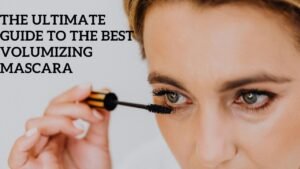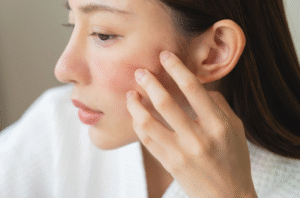Have you ever woken up with a painful, inflamed lump near your eyelid? If so, you’ve likely experienced a common eye infection that causes redness and swelling of the eyelid glands. Stye can crop up for a variety of reasons but one suspected culprit is mascara use.
As a makeup product applied so close to the sensitive eye area, mascara has the potential to transfer or harbor bacteria. In this blog post, we’ll look in-depth at the link between mascara and styes. We’ll explore whether old, new, or improperly used mascara can directly lead to a stye forming.
Understanding factors like hygiene, timing of replacement, and contamination routes is key to preventing future infections. I’ll also provide an overview of stye symptoms, risk factors, and treatment steps. You’ll have a comprehensive understanding of how mascara may or may not cause styes, and more importantly, how to reduce your risks. Let’s start with what a stye is and what signs to look out for.
What Is a Stye?
It is a bacterial infection of the glands at the base of eyelashes or eyelids. It causes sudden redness, swelling, pain, and tenderness of the eyelid. Styes are most common among preteens and teenagers.
Symptoms of a Stye
The main symptoms of a stye include:
- Red, swollen lump near the edge of the eyelid or at the base of an eyelash
- Tenderness or pain around the eyelid
- The feeling of warmth, tenderness, or pressure around the eye
- Watery or puffy eyes
- Sensitivity to light
Risk Factors for Developing a Stye
Certain factors may increase the risk of developing a stye:
- Touching or rubbing eyes with dirty fingers
- Poor hygiene of makeup tools like mascara wands or eyelash curlers
- Direct contact with someone who has a stye
- Poor hygiene and sanitation of towels, washcloths, or pillowcases
- Conditions like blepharitis (inflammation of eyelid margins)
- Not removing all makeup before sleeping
- Using expired makeup products
Can Old Mascara Cause a Stye?
Yes, old mascara can potentially cause a stye. As mascara ages, bacteria naturally grow on the wet brush or applicator. Putting an old, bacteria-laden mascara wand near the eyes risks transferring those microbes and causing an infection. The bacteria buildup is more likely in mascaras that are 3 months old or older.
Can New Mascara Cause a Stye?
While less common, new mascara can cause a stye if the product was contaminated during manufacturing or packaging. Even though mascara containers are sealed, foreign bacteria could have potentially entered before sealing. To reduce risk, only buy mascaras from reputable brands sold in stores with good turnover to ensure freshness.
Can Wearing Mascara Cause a Stye?
Wearing mascara can potentially lead to a stye developing if good hygiene and sanitation practices aren’t followed:
- Not washing hands before and after applying mascara risks transferring bacteria to the eye area.
- Reusing old, crusty mascara wands with bacterial buildup poses a high infection risk near the eyes.
- Rubbing or touching eyes with mascara-laden fingers risks introducing microbes that could cause a stye.
Can Sleeping With Mascara Cause a Stye?
Leaving mascara on overnight is a leading cause of styes. While sleeping, fingers or fabrics like pillowcases can easily transfer any bacteria from mascara onto the eyes. It’s best to thoroughly remove all makeup before going to bed to reduce risks.
Can I Wear Makeup with a Stye?
It’s not recommended to wear eye makeup, including mascara when you have an active stye infection. The makeup can irritate the stye and spread bacteria from fingers or tools to the other eye or person. Wait for the stye to fully heal before reintroducing makeup.
Can Makeup Cause Styes?
Poor makeup hygiene can increase stye risks. While mascara is a common cause, any cosmetic products like eyeliners, eyeshadows, or makeup brushes contaminated with bacteria could potentially trigger a stye if not properly cleaned or sanitized. It’s important to dispose of old makeup and clean tools regularly.
How to Prevent Styes
To reduce stye risks:
- Wash hands thoroughly before and after applying makeup
- Replace mascara every 3 months
- Clean eyelash curlers and makeup brushes weekly with soap and warm water
- Avoid rubbing, touching, or pawing at eyes
- Wash pillowcases weekly in hot water
- Get enough sleep and manage stress
- See an eye doctor if styes become frequent
How to Treat a Stye
To treat a stye at home:
- Apply a warm compress for 10 minutes, 3-4 times per day to bring the infection to a head
- Gently clean the eye area with a soft cloth soaked in warm water
- Avoid touching or rubbing the stye
- Take over-the-counter pain relievers
- See a doctor if the stye is especially painful or doesn’t improve within a week
Take Key Points
- Styes are caused by bacterial eye infections and are contagious
- Old, unsanitary mascara is a common cause but proper hygiene prevents issues
- Removing all makeup before sleeping and replacing mascara regularly reduces the risks
- Warm compresses help treat styes at home but see a doctor for frequent occurrences
Frequently Asked Questions
How do you get rid of a stye from mascara?
Apply warm compresses, take an OTC pain reliever, and discontinue mascara use until fully healed. Clean brushes and sanitize lids weekly going forward.
Why do I get styes every time I wear mascara?
You may have poor hygiene, allergies, blepharitis, or hormonal issues. See an ophthalmologist to investigate the cause and get appropriate treatment.
Can eye makeup cause styes?
Yes, if not properly cleaned or sanitized, any cosmetic around the eyes like mascara, eyeliner, or brushes can potentially cause a stye by transferring bacteria.
What mascara does not cause styes?
High-quality mascaras from reputable brands, when used and stored properly, are less likely to lead to styes. Discard expired products or those showing signs of bacteria.
Final Thoughts
While mascara on its own does not inherently cause styes, improper use and hygiene practices with mascara can increase one’s risk of developing an eye infection in the form of a stye. Following recommended guidelines for mascara storage, application, removal, and tool sanitization prevents bacteria from being transferred near the eyes.
It’s also important to watch out for other risk factors like poor sanitation of towels, brushes, or pillowcases. With care, diligence, and early treatment, styes induced by mascara or other factors can usually be avoided. By understanding the role of bacteria, hygiene best practices, and lifestyle factors, you can minimize your chances of an unpleasant.
If one does occur, following home remedies and monitoring for medical attention provides the best opportunity for a swift recovery. With prevention and care in mind, you can continue enjoying makeup application while reducing risky eye infections.











